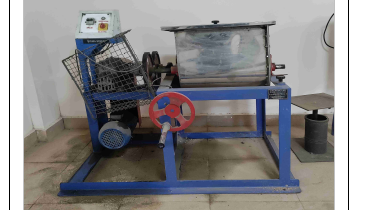Vision
The Department aims for global recognition in teaching, research and community services and raising the standard of Chemical Engineering education in the latest art of the technology, constantly improving the quality and skills at undergraduate and post graduate levels, emphasizing on novel research and development that leads to a socioeconomically feasible technology.
Mission
To impart quality education in the field of Chemical Engineering to produce professionally competent engineers for the benefit of the society at large.
List of Experiments:
Experiments to be performed:
Total twelve experiments; six experiments from each section.
Section (A): Fluid Particle Operation
1. Determination of Rittinger’s & Kick’s constant in respect of the laboratory Jaw
Crusher, Ball Mill, Hammer Mill/Roll Crusher
2. Determination of arithmetic mean, surface mean, volume surface mean diameter
and volumetric mean diameter, and specific surface area of given sample.
3. Determination of effectiveness of screen
4. Batch settling study for given slurry and determination of thickener area.
5. Determination of the efficiency of the Crusher for crushing a material of known
working index
6. Determination of the efficiency of a Ball Mill/Rod Mill for grinding a material of
known work index.
7. Study of the effect of RPM on the power consumption of a Ball Mill/ Rod Mill.
8. Determination of the velocity of water for the separation of equal sized particles of
different densities.
9. Determination of the velocity of water for separating the given solid mixture of
the same density on the basis of size.
10. Study of the operation of a Hammer Mill/Filter press in the laboratory.
11. Evaluation of the specific cake resistance and medium resistance in Filter press.
12. Study of the working of Screw Conveyor/ Sigma mixer.
13. Study of the performance of a given Cyclone Separator.
14. Study of the effect of inlet gas velocity on overall efficiency in a Cyclone separator.
Section (B): Fluid Mechanics
1. Determination of the discharge coefficient of given Venturi meter.
2. Determination of discharge coefficient of given Orifice meter.
3. Determination of friction factor and head loss in given pipe assembly.
4. Determination of the discharge coefficient of given rectangular notch.
5. Determination of the discharge coefficient of given V- notch.
6. Verification of Bernoulli’s theorem experimentally.
7. Determination of the pressure drop across packed column.
8. Determination of the friction factor/ pressure drop across contraction in
a given pipe assembly.
9. Determination of the equivalent length of double pipe assembly.
10. Determination of the time required to empty an open hemispherical tank and
coefficient
11. Calibration of the given Rotameter.
| S.No. | Instrument | Image |
|---|---|---|
| 1 | Jaw Crusher |  |
| 2 | Settling Velocity |  |
| 3 | Ball Mill |  |
| 4 | Screening |  |
| 5 | Rod Mill |  |
| 6 | Hammer Mill |  |
| 7 | Roll Crusher |  |
| 8 | Sigma Mixer |  |
| 9 | Cyclone Separator |  |
| 10 | Plate and Frame Filter Press |  |
| 11 | Screw Conveyor |  |
